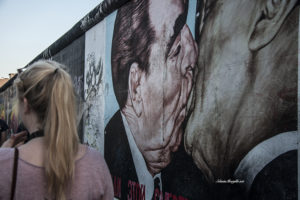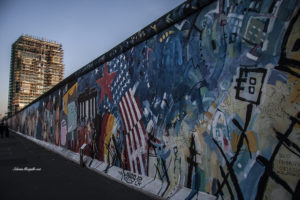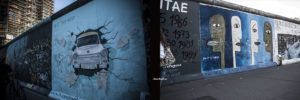East Side Gallery in Berlin
Italian Version Below*
Once in Berlin, one often wonders … but where was the Wall?
The best-preserved part, about 1.3 km is visible in the district of Friedrichshain (ex-East Berlin), along the Mühlenstraße. It is known as East Side Gallery!
The construction of the wall began on August 13, 1969, and has divided the city for 28 years.
When the East German government announced on 9 November 1989 that travel to the west was possible again, the east wall appeared as a huge white palette. So it became the perfect medium for over 100 artists from all over the world! They sought to express values such as Liberty and Peace through their art.
Among the most famous and reproduced murals are the Trabant that breaks through the wall of Birgit Kinder entitled “Test the Best / Rest”, the Kiss by Dimitri Vrubel better known as “The Mortal Kiss”, the Colored Heads of Thierry Noir and Dancing to Freedom of Jolly Kunjappu.
The Trabant was born as the car of the East German people and was represented by the artist B. Kinder in 1990 with the emblematic title “Test the Best” which echoed a well-known cigarette commercial at the time ( est the West). We wanted to promote a western lifestyle as opposed to the ideology and restrictions of the Soviet system.
Dimitri Vrubel, Russian painter, however, is the author of the “kiss” by Leonid Brezhnev and Erich Honecker. In 1979 on the occasion of the thirtieth anniversary of the German Democratic Republic, Leonid, secretary-general of the Communist Party of the Soviet Union and Erich, German politician president of the GDR, exchanged a “Soviet kiss” which quickly became a manifesto of the Cold War.
The photograph of the kiss was widespread and Dimitri translated it into this mural; moreover, he decided to put on the top, being an artistic externalization in a satirical key, the Cyrillic phrase “My God help me to survive this mortal love”.
In 2009, for the twentieth anniversary of the fall of the wall, the work was completely restored (made from scratch) by the artist.
The colored heads of Thierry Noir were among the first murals to be made. The French artist had moved to the German capital in the early 1980s and had started painting on the Westside at night. For this reason, the figures he designed were stylized, with simple profiles and reproducible even in low light.
The “Dancing to Freedom” mural by Jolly Kunjappu also places itself on the same “colored” vein, where two figures dance around a sun. The wording “no more wars no more walls” is more explanatory than any other explanation!
Since 1992 the East Side Gallery has obtained recognition as a national monument.
All rights reserved*
Arrivati a Berlino, spesso ci si chiede… ma dove si trovava il Muro?
La parte meglio conservata, circa 1,3 km è visibile nel quartiere di Friedrichshain (ex Berlino Est), lungo la Mühlenstraße. E’ nota come East Side Gallery!
La costruzione del muro iniziò il 13 Agosto 1969 ed ha diviso la città per 28 anni.
Quando il 9 Novembre 1989 il Governo della Germania Est annunciò che i viaggi verso Ovest erano nuovamente possibili, il Muro verso Est si presentava come un enorme tavolozza bianca. Fu così che divenne il supporto perfetto per oltre 100 artisti, provenienti da tutto il mondo! Essi cercarono di esprimere attraverso la loro arte valori come la Libertà e della Pace.
Tra i murales più famosi e riprodotti ci sono: la Trabant che sfonda il muro di Birgit Kinder dal titolo “Test the Best/Rest”, il Bacio di Dimitri Vrubel meglio noto come “The Mortal Kiss”, le Teste Colorate di Thierry Noir ed il Dancing to Freedom di Jolly Kunjappu.
La Trabant era nata come l’auto del popolo tedesco dell’Est e fu rappresentata dall’artista B. Kinder nel 1990 con l’emblematico titolo “Test the Best” che faceva eco ad uno spot pubblicitario di sigarette molto noto all’epoca (Test the West). Si voleva promuovere uno stile di vita occidentale in contrapposizione all’ideologia e le restrizioni del sistema sovietico.
Dimitri Vrubel, pittore russo, invece, è l’autore del “bacio” di Leonid Brezhnev e Erich Honecker. Nel 1979 in occasione del trentennale della Repubblica democratica tedesca, Leonid, segretario generale del Partito Comunista dell’Unione Sovietica ed Erich, politico tedesco presidente della DDR, si scambiarono un “bacio alla sovietica” divenuto in breve tempo manifesto della Guerra Fredda.
La fotografia del bacio fu ampiamente diffusa e Dimitri, la tradusse in questo murales; inoltre, decise di apporre in cima, essendo un’ esternazione artistica in chiave satirica, la frase in cirillico “Mio Dio aiutami a sopravvivere a questo amore mortale”.
Nel 2009, per il ventennale della caduta del muro, l’opera è stata completamente restaurata (realizzata ex novo) dall’artista.
Le Teste colorate di Thierry Noir sono state tra i primi murales ad essere realizzati. L’artista francese si era trasferito nella capitale tedesca all’inizio degli anni ‘80 ed aveva iniziato fugacemente di notte a dipingere lungo il lato Ovest. Per questo motivo le figure che ideava erano stilizzate, dai profilo semplici e riproducibili anche con poca luce.
Sullo stesso filone “colorato” si pone anche il murales “Dancing to Freedom” di Jolly Kunjappu dove due figure ballano intorno ad un sole. La scritta “ no more wars no more walls” è più esplicativa di ogni altra spiegazione!
Dal 1992 la East Side Gallery ha ottenuto il riconoscimento di monumento nazionale.
Sostieni #laculturachevince, aiuta la condivisione.


